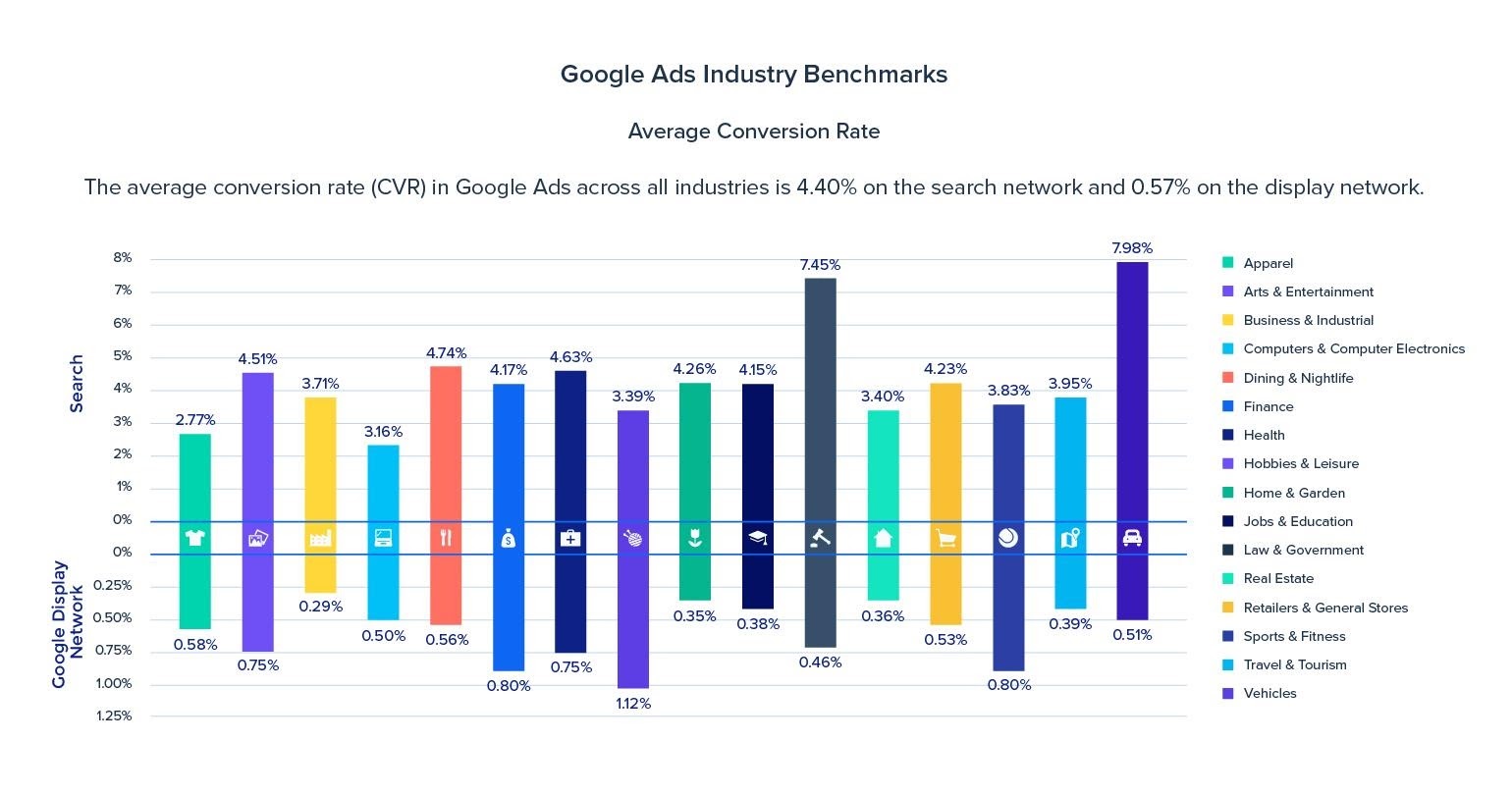It’s been 20 years since the launch of Google Ads, and yet, many advertisers have continued to rely on the same PPC tactics they’ve always used—resulting in an average conversion rate of just 4%. While this may have been an acceptable standard in the past, it isn’t today. If your PPC tools and tactics are costing you a 96% wasted ad spend, it’s worth re-evaluating your approach.
What is SEM?
Search Engine Marketing (SEM) is a digital marketing practice that utilizes paid strategies to increase search visibility. At one time, search engine marketing referred to both paid and organic search strategies; but in current vernacular, SEM has come to refer strictly to paid search advertising—also known as pay per click (PPC)—and Search Engine Optimization (SEO) is treated as a separate discipline.
Within the SEM ecosystem, Google Ads is the most popular search ad network due to the volume of searches conducted through the Google search engine (billions of searches per day). Microsoft Advertising (formerly Bing) is a distant second to Google in volume, but has the advantage of exclusively serving Yahoo search traffic—powering several digital assistant voice searches—and has the ability to target searchers within LinkedIn profile data.
Below you’ll find seven search engine marketing best practices that are proven to boost your conversion rates and improve your ROAS.
1. Ditch the “get more clicks” mindset
The first step to a successful SEM strategy is to adopt a conversion mindset.
Given that digital marketing tactics tend to be influenced by the networks selling the ad space, it’s not surprising that marketers’ focus would be on driving as many clicks as possible.
Ask any SEM expert where they spend the most time on a campaign, and the majority will tell you it’s on keywords, ad copy, and optimizing for lower-cost keywords and ad groups. These are all activities geared toward earning clicks.
But every SEM campaign has two halves:
- The pre-click stage—when the customer enters a search query and sees your ad.
- The post-click stage—when the customer converts (or doesn’t) on the landing page.
The majority of digital advertisers prioritize driving traffic, taking for granted what happens after the click. And this is why the average conversion rate is so low (4.4% on the Google Ads Search network). When you focus on maximizing clicks, you’re driving a few good leads along with a lot of bad.

PPC advertisers have long accepted these numbers as standard benchmarks, but when 95.6% of paid clicks don’t end in conversions, that’s a lot of wasted ad dollars.
To improve your ROAS, your SEM campaign should be focused on earning conversions. After all, your goal is to earn paying customers, not window shoppers.
2. Target the right keywords
Being conversion-focused doesn’t mean forgetting about keywords, it means targeting the right ones. Your goal should be to do everything you can to target high-intent keywords.
Long-tail keywords, because of their narrow focus, are relevant to fewer competitive businesses. This generally makes them lower cost. But, in addition to being cheaper, long-tail keywords are also more likely to signal conversion or buying intent.
For example, someone searching “1080p HD portable projector” is more ready to buy than someone searching “computer projector.”
Targeting the right keywords will help increase the relevance of your ads, boosting your Quality Score, reducing your cost per click, and earning you more conversions.
3. Personalize your ad campaigns
SEM campaigns are often written using a formulaic approach that supports tactics such as dynamic keyword insertion (DKI), which makes it easy for the marketer to create very specific, highly targeted ads at volume. However, from the user’s perspective, these ads feel cold and impersonal. And to no surprise, research tells us that customers don’t want keyword-stuffed ads, they want personalized experiences.
Research conducted by Accenture found that 83% of consumers are willing to share their data to enable a personalized experience. Privacy is a sensitive topic, however, and the Accenture research points to a critical line in the sand between information consumers give willingly versus data brands collect without their knowledge or permission. Trust and transparency go hand in hand with personalization.
What does this look like in practice? Start by creating a clear picture of who your customers are. The following data points can help you segment your target audiences:
- Demographic (e.g., age, gender, income)
- Psychographic (e.g., values, attitudes, interests)
- Firmographic (e.g., company, industry, title)
- Geographic (e.g., city, state, country)
- Behavioral (e.g., page views, downloads, signups)
- Transactional (e.g., purchase history)
Using customer data for personalization in a manner that creates value to customers is the key to their success. McKinsey research indicates that personalized ads achieve up to 30% greater marketing spend efficiency.
So if personalization is so effective, why don’t more marketers personalize their ads?
4. Ensure message-match between ads and pages
Part of effective personalization is making sure your ads and landing pages tell a cohesive story from start to finish. It may sound obvious, but a surprising number of ads drive traffic to landing pages that don’t align with the ad message.
The key is to state the same value proposition and include the same messaging across your ads and landing pages. That way, your visitor will know right away that they’ve landed at the right destination. For example, if your ad mentions “zero fees,” the same phrase should be echoed on your landing page. This practice, which connects your pre- and post-click SEM experiences, is known as message matching.
5. Maintain a 1:1 ratio of ads to landing pages
A best practice of any search engine marketing program is establishing a 1:1 ratio of ads to landing pages. This means creating a separate landing page for each of your key terms with the objective of creating a highly relevant post-click experience for every search. There may be some overlap in content, but at minimum, the page’s title, headline, copy, imagery, products/services, and CTA should be tailored to the specific keyphrase targeted by your ad.
For example, a search for “blue umbrellas” should go to a landing page for blue umbrellas. A search for “pink umbrellas” should go to a landing page for pink umbrellas. While it might be tempting to streamline the process by creating a single generic page of umbrellas of any color, it would result in lower conversions.
Executing this level of specificity requires an investment in production resources, but it does pay off. Creating tailored landing pages for each of your top search terms can reduce your CPC by as much as 50%.
6. Follow conversion-centered design principles
Once your ad has done its job and compelled prospective customers to click, your landing page is responsible for the second half of the journey. Designing your landing page based on established UX best practices will help ensure the success of your SEM campaign.
At their best, landing pages are focused, persuasive, and user friendly. Following a few conversion-centered design best practices will help you turn SEM-generated traffic into business:
- Benefit-oriented headline: Clearly communicate your unique selling proposition in your headline.
- Visual hierarchy: Use size, space, contrast, position, and proximity to guide the user’s attention in the desired order.
- High color contrast: Use colors that pop to draw attention to your forms and CTA buttons.
- Concise copy: Optimize text for readability with small, concise text blocks, bullet points, subheadings, and bolded words.
- Simple forms: Keep forms simple and direct, with clear labels and error messages, and make sure they are short and easy to complete.
- Helpful media: Be mindful of using images and videos that support your message or convey supplementary information without distracting the visitor.
- Message match: Make sure your landing page messaging is a continuation of the message communicated by the ad that brought the visitor to the page.
These UX principles work together to remove barriers and help guide prospective customers to take the desired action.
7. Test and optimize constantly
The practice of conversion rate optimization (CRO) involves continually improving your post-click landing page experiences by incorporating learnings to maximize conversion
Following best practices will get you started in the right direction, but they aren’t a substitute for testing. Even if you create what feels like perfect ads and post-click landing pages, you’d be surprised how much A/B and multivariate testing can push your conversion improvements.
A/B testing involves isolating individual variables and then testing one landing page design against another. For example, you could A/B test two pages with different headlines to determine which achieves greater conversion.
Multivariate testing involves testing changes between multiple page elements together to see how they interact with each other. For example, testing two different page headlines, two header images, and two opening paragraphs would allow you to test eight different page variants.
By repeatedly testing your post-click landing pages against alternate versions and incorporating the learnings into new page designs, you will increase your conversion rate consistently over time while uncovering insights that can be applied to future campaigns.
Pair your SEO efforts with fully optimized landing pages
Optimizing for organic search means nothing if the landing page it leads users to isn’t fully optimized. Instapage can help. We offer three different plans to help take the stress out of building, optimizing, and converting—helping you to create better landing pages and see better results. Schedule an Instapage demo here.
